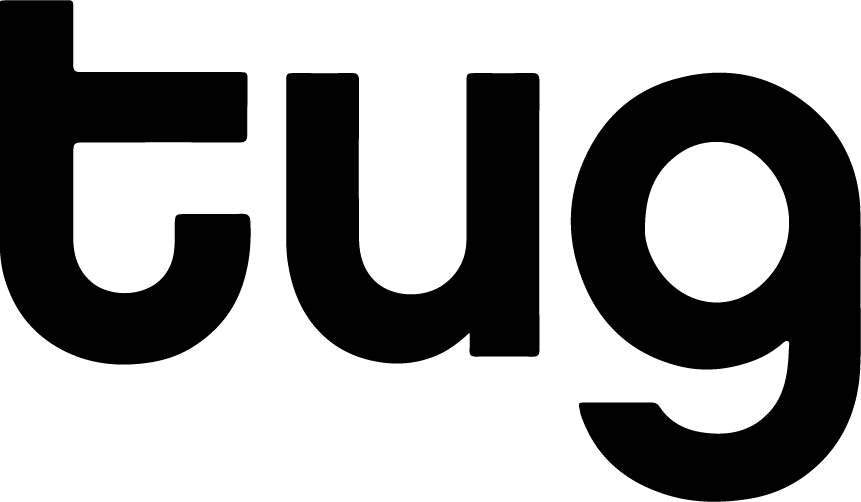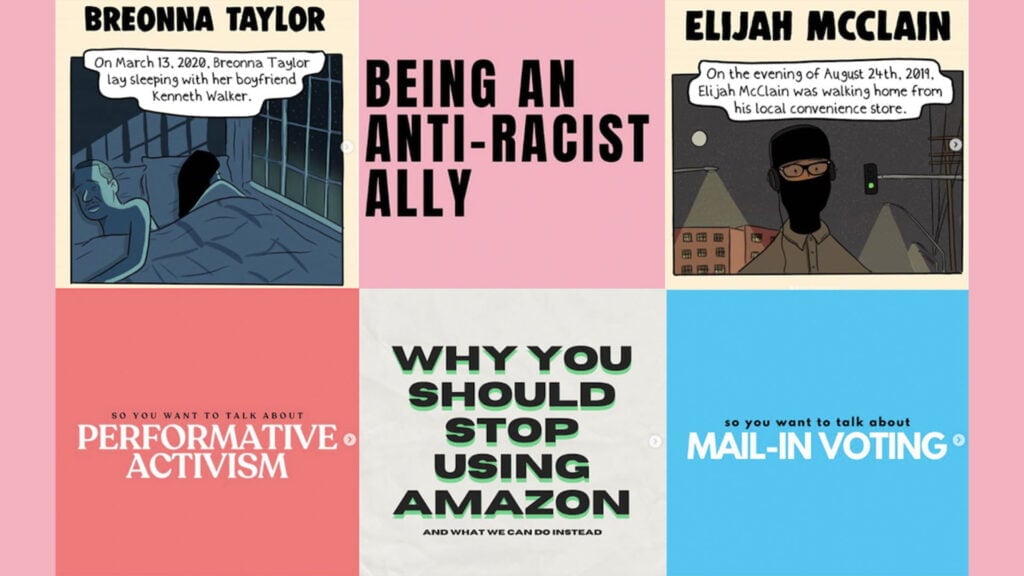With increasing numbers of emerging channels and technologies available for marketers, today’s campaigns are extremely innovative, impactful and creative.
Successful ad campaigns have the power to stir up emotions and stay in our memory for a long time, influencing our style, opinion, buying decisions and brand loyalty.
1. Bodyform #Wombstories
In 2020 they created their boldest campaign to date. Created by AMVBBO, #Wombstories reveals the emotional, complicated and sometimes painful realities of women’s intimate experiences. Their challenge was to stay true to the brand’s taboo-breaking values in a highly sensitised environment and overcome media policies.
In the film you can notice two parallel journeys of a woman who decides not to have children and another one who faces the trials of IVF and miscarriage. Also featured are a character who has endometriosis, an older woman going through the menopause and a girl who gets her period for the first time. Representing the emotional rollercoaster of women’s relationships with their uteruses and vaginas.
With #wombstories, Bodyform & Libresse want to encourage an open culture where everyone can express what they go through without fearing they won’t be properly believed without feeling shamed. The pleasure, the pain, the love, the hate. It’s never simple but it all needs to be heard. They believe that this culture of silence reinforces taboos and impacts women’s confidence and wellbeing, and that these taboos are weakened by open and honest conversation.
The animation is strong enough to draw a clear line between what was going on inside a woman’s body to what was happening in the real world. So each womb featured in the ad had a different illustrator assigned to it in order to give it an identity as distinct and unique as its owner’s. Also, on their website Bodyform encourage women to share their experience about their periods. You can find a form that you can fill out and be published on their website.
How did audiences engage on social media?
- YouTube: 679,876 views, 12k likes
- Facebook: 19k likes, 1.2k comments and 14k reshares
- Twitter: 2.3k Retweets, 1K Quote Tweets and 3.4K Likes
- Instagram: Over 1.2 million views, 54.6k likes, 1.7k comments
2. Just Eat “Did somebody say” ft. Snoop Dogg
Just Eat, the online food ordering and delivery service, released a campaign in May 2020 with Snoop Dogg that fitted straight into the brand’s wider media mix, helping take the campaign’s concept up a notch with some added star power. Snoop Dogg takes issue with the existing Just Eat jingle, prompting him to create his own version sharing his love of eating food.
Created by McCann London, Directed by François Rousselet often called “2020’s biggest collaboration”. The global campaign was devised to reiterate Just Eat’s brand message – that it isn’t a traditional weekend takeaway treat, but for all food delivery occasions. It targeted a youth audience with cool and appealing creative that resonated with urban culture. Teams at McCann London and CRAFT did amazing work making this a reality.
The film was shot at the iconic Disney studios in Burbank (the studio where Mary Poppins was filmed). It is created to mirror a genuine, cool, hip hop video with fresh and surprising slicks and contrasting scenes to look fun and make people smile. Using mixed media of video, animation, stills and typography overlays. The cinematography of the film is very stylish and contains eye-catching colours.
The ad was trailed with 15-second digital teasers and included bespoke content across Snapchat, YouTube, TikTok and gaming platform Twitch, complementing the TV push and wider sponsorship strategy.
How did audiences engage on social media?
- YouTube: Over 12 million views
- Facebook: 556 likes, 1.3k comments and 460 reshares
- Twitter: 202 Retweets, 23 Quote Tweets, 305 Likes, 27.7 views
- Instagram: Over 23k views, 3604 likes and 259 comments
Takeaway culture is now a bigger part of our lives than ever before. When the world feels chaotic and strange, bringing a little bit of normality and humour is the key. Hopefully, it provides some light relief for everyone who sees it.
3. BBC, Dracula
To mark the release of flagship drama Dracula at the beginning of the 2020, the BBC took inspiration from the dark and shadows to create an out-of-home installation that came to life as dusk falls – a genius idea!
By day the billboard appeared to feature a random collection of bloody wooden stakes. But as darkness descended and a spotlight was turned on, it revealed the shadow of Dracula himself.
BBC chose the outdoors for its ability to build fame among youth and light TV audiences. Two sites were selected – one in London and one in Birmingham – that together helped rack up more than 320,000 impacts.
The creativity of the execution caught people’s attention, with the public response driving huge earned reach across social and publisher platforms.
- YouTube: Over 155k views
- Facebook: 17k likes, 934comments and 3.4k reshares
- Twitter: 35,000 Retweets, 500 Quote Tweets, 134, 000 Likes (couldn’t find a link)
The campaign received heavy PR coverage, with more than 40 articles written about it across both national and industry press.
There were an estimated 43,000 social posts about the ad, generating a reach of 22 million people.
Why I love these design executions
The design of these creative campaigns is an integral part of the message – it’s not there just for the sake of aesthetic appreciation. The examples we’ve looked into use design to extend the advertisements’ emotional, commercial and cultural notions.
When creating visually engaging marketing campaigns that entice the audience to act or react, it’s worth remembering that these campaigns should always feel authentic to the masses and individuals.
This blog post is a condensed version of a webinar – If you prefer to watch the video go here!
At Tug, we have worked with SaaS brands for the past 12 years and we know that they are passionate about their products. Sometimes, however, passion can be as much of a hindrance as a help when it comes to creating brilliant creative because the audience for your product, quite often, just doesn’t care as much about software as you do. Small business owners have enough on with their day-to-day and IT leaders at larger companies are reporting that staying on top of an increasingly complex tech landscape is more difficult than ever.
And that’s in a normal year! In a pandemic year, talking about your product won’t get cut through. What your audience wants to hear is:
- How you will solve their immediate problems
- How you will help grow their business
So why are we still seeing ads like this?
What is wrong with these ads:
- They list out product features rather than focus on user need
- Creative looks like an ad not social content made for Facebook where they appeared
- Too much text for a news feed
I am sorry to pick on Guesty and Zoho – they are simply the first two bad ads I saw in the Facebook Ads Library tool – but they are far from alone. Recent research from The LinkedIn B2B Institute and System1 found that of 1,600 ads served to six million people over four years, that only one in four would have received more than one out of a possible five stars for quality of creative. Ouch! This study proposes that B2B creative is in crisis because B2B firms, unlike their B2C counterparts, aren’t marketing-led. They are led by engineers or sales people – rational types. And when creative is poor and garners poor results – their views about its importance are only reinforced.
The five elements of great B2B creative are:
- A narrative or story arc
- Characterisation or relatability
- A soundtrack or voice over (this is more and more important for social media as news feeds are overtaken by Snaps, TikToks, Stories and Reels)
- Emotion
- A recognisable brand device (logo, visual brand identity, tone of voice)
So how do you make five- star creative for your SaaS brand?
First, know your audience. I think many marketers still think of tech decision-makers as being the old guy in the corner office. This is no longer the case – evidence points to Millennials being increasingly involved in procurement decision making due to their seniority and tech-savviness.
Key traits of Millennials
- Tech-savvy – they are true digital natives
- Self-improvers – they love to add new strings to their bow, see themselves as a work in progress
- Socially and ecologically aware – they align themselves to brands with positive purpose
- More likely to trust brands they are familiar with – more evidence not to ignore top of funnel brand marketing for SaaS
- See themselves as trendsetters – BUT they are scared of falling behind so often not so much leading as following
- They care about the competition – more likely than older generations to base purchase decisions on what others are doing.
Secondly, take into account the channels your marketing will appear on.
Making content that works on social channels
- Your content will need to fit into a news feed environment – if it looks like an ad people will scroll onto family photos and news stores
- News feeds – and Story and Reel feeds – move quickly so you need to grab attention early on
- Moving image can help draw the eye quickly in a news feed but even then you only have about three seconds to hook the user
- Use emotion – for example people’s faces – in order to make that quick connection.
What are some great examples of SaaS social and digital content?
Mailchimp has recently partnered with the creatives at It’s Nice That on an animated series about the highs and lows of work – whether that be in a start-up or a larger organisation. This content looks beautiful and is an entertainment destination in its own right and goes to show that you can create interesting, entertaining and emotive content if you’re a B2C software brand. I also love what Sage are doing with their #BossIt2021 challenge – the first I’ve seen from a B2B brand. What a great way to connect with a new generation of entrepreneurs and passionate small business owners about what inspires them.
And here’s a simple example from our own client Bluebeam, who make software for the construction industry, of just what happens when you follow creative best practice for SaaS:
Yes that’s a 312.5% uplift in Conversion Rate after they focused on solving the user’s problem and connected with their audience using emotion.
Focus on these four pillars to elevate your SaaS marketing:
- Solving immediate users pain points
- Demonstrating how you can help grow their business
- Understand how Millennials see themselves eg socially aware
- Cater to Millennial behaviours eg care about what competitors are doing.
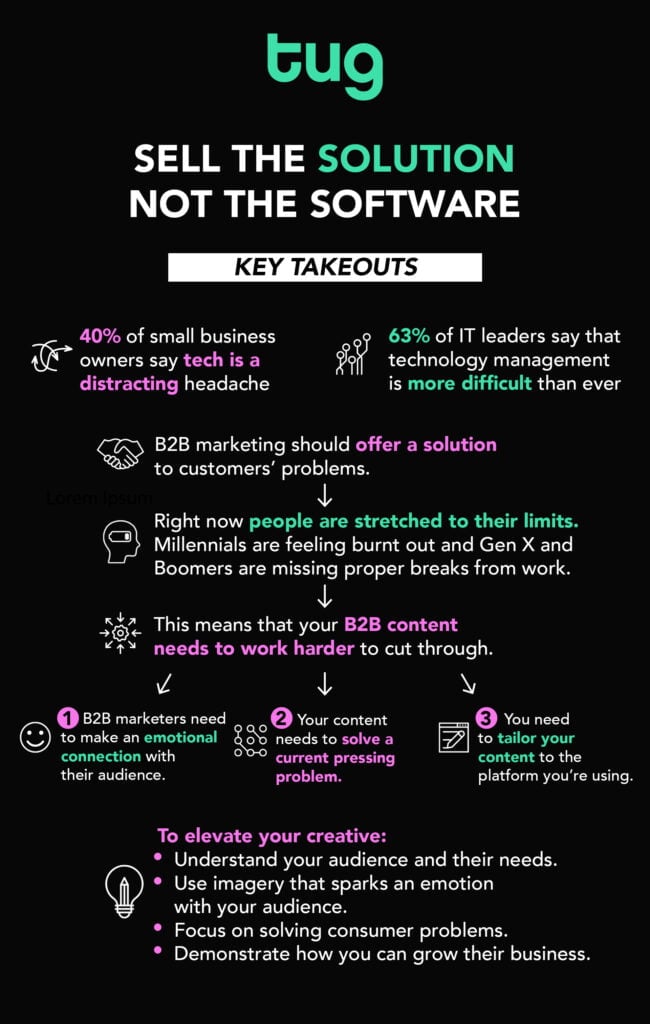
What is Clubhouse like?
There’s a new invite-only social app which is causing minor waves among marketers and early adopters around the world if my LinkedIn feed is anything to go by.
I have finally scored myself a Clubhouse invite so I can report to you what it’s like inside.
At first glance, everything about Clubhouse is a bit strange. This is not just another Facebook, and it has none of the familiarity of popular social media channels. For a start it’s audio-only – a far cry from the visually stimulating news feeds of Instagram and TikTok. Even its app icon is odd – a black and white photo of a guy clutching a guitar rather than a cute little symbol.
The experience is a bit like a conference where you wander about into different ‘rooms’ and hear what people are saying in them. You can pop in and out at will – and each room has assigned speakers and an audience. All the rooms are about different subjects indicated by their name – I heard a little about pitching your start-up, ensuring your chakras are aligned, and a bit about the music industry. One was in Mandarin so I am not sure that that one was about. Much like a conference the only people I heard talking on my first foray were men – but perhaps I am not following the right people yet. One room I entered had an audience of 3,000 members.
Like any social network – your inputs will form your output. Follow the right topics and people and you should be rewarded with content that interests you. My first visit was not the most scintillating – but as I stick around and refine who I am following that should improve.
What is Clubhouse for?
Users can listen to panels, conversations and discussions from influential people in that area. It’s somewhere between a live podcast and an industry conference. And once it’s done it’s done – the platform doesn’t save the conversation for later. It’s a live, by-appointment platform.
When you join up you can follow individuals and topics so the ‘rooms’ are tailored to you.
Why have I heard of Clubhouse?
In early February Elon Musk hosted a chat with the CEO of viral trading app Robinhood – the chat was also livestreamed on YouTube – which spiralled it out to the mainstream. In mid-February it was booted out of China – where it had been very popular due to the lack of censorship.
Why is Clubhouse so popular?
Although it’s a live audio platform, you can listen to others without there being any requirement to speak, and you can dip in and out of rooms without announcing your coming and going in a prominent way, so users can enjoy listening passively.
The audio-only element is interesting because it means that you can engage while doing other things – a little like the way people engage with radio. You don’t need to be staring at your screen the whole time – although there’s the option to lean in and join discussions if you like. This brings to mind YouTube’s recent decision to offer audio-only ads – aimed at the large number of people who use that app in a more passive way.
Currently, Clubhouse is populated by influential techy types and users with big social followings on other social networks – and there’s an air of exclusivity from the invite-only nature of the launch.
Why is it invite-only and how can I get one?
The hype, silly! No one wants anything more than the thing they can’t have. So, if you want in you need to know someone who is already in there. Every member gets two invites when they join.
You can expect the app to open up to the general public in time.
How big is it?
As of the beginning of February 2021 Clubhouse has 2 million users. It’s valued at $1 billion.
What’s the brand opportunity?
The most obvious and immediate opportunity on Clubhouse is for brands wanting to drive thought leadership and generate new business leads, particularly within the subject areas which are popular already on the app – think tech, wellness, business and trading for a start. The app currently gives you access to early adopters who are passionately interested in a particular subject matter, so if you have something interesting to say or can answer questions with authority, then you can have a platform on Clubhouse. There’s also the opportunity of sponsoring popular rooms – much like you can at a real-world industry event. Many of the current Clubhouse users are Silicon Valley denizens, and rooms are being used to pitch business ideas and win funding from investors – with reported million-dollar deals going down within the app.
Aren’t we all hounding for that exclusive Social Media growth hack tip? That eternal chase of engagement rates, increase in follower numbers, and viral potential of your content strategy?
Regardless of whether we’re simply beginning or we’re a well-seasoned veteran with multiple accounts and an extensive portfolio, there’s one biblical statement in the word of advertisement we can all swear by:
“Words can be more important than visuals.”
Shocking? It shouldn’t be. While visuals attract attention and retain interest, it’s words that convert. That’s the best advice that was given to me about social media. Here’s why.
1. Social Media influences decision making
Studies show that Social Media is now a pivotal part of the decision-making process of 70% of millennials, who buy a product based on recommendations made by their peers. But the real power might just lie in the words chosen to feature on the visuals and the ad copy within those social posts!
Social Media copy is just as important as website copy. We all go on social media to be entertained, to connect with others, and to learn new things. But don’t lose sight of the end goal when writing social copy – you’ll still need a call to action!
2. The link between SEO and Social Media
Links shared on Social Media increase brand exposure and give your blogs and articles a longer lifespan of content, increasing online visibility and organic traffic. Although social media does not directly increase page ranking, social signals are de facto generated, indicating that your posts are useful to the market you are targeting.
These vital signals are picked up by Google and other search engines to rank your website. This is important to recognise, especially when there are almost five million blog posts published daily reducing the odds of your site ranking high on search engine results. This makes copy for social even more important, as it could drive more traffic to your site.
3. Copy provides context
It’s far better to give viewers a clear idea of the meaning behind imagery and video on social media – and this is where the copy is important. Clear social copy prevents people from misinterpreting the meaning of images or videos. With as much as 85% of video views on Social Media happening with the sound off, the importance of ad copy and video captions cannot be overstated.
If it isn’t possible tocaptions to every video you post, the least you can swear by is editing in words to depict the synopsis of what is being said in the video so your audience.
Yes, a badass image works! You will get thousands of likes, but if you want to grow your brand, you need to add “genuine and authentic” value on top of the visuals, and that happens with the copy. From a digital perspective, content can never go out of fashion. We are all human, we thrive on the spirit of story-telling. And with the right approach of tone, pitch, and style aligned with brand voice, context can always chime in.
Last week, YouTube announced the launch of new audio advertising formats as part of their slate of audio investments in 2020. Other announcements have included new sales capabilities in AdsManager and better optimisation opportunities in DV360. With more than 50% of logged-in users listening to more than 10 minutes of music per day, audio ads fit seamlessly into media plans already utilising YouTube. Our top three tips to get the best out of these ads are as follows:
Keep it Casual
When creating audio assets to use on YouTube, remember that you’re intruding upon someone’s listening. Nobody *wants* to listen to ads when they have a playlist on and so it’s imperative to make sure the tone is casual but succinct. We recommend a softer spoken voiceover with a clear mention of the brand and product within the first sentence. These ads are only 15” long so it’s important that the message is clear. Your script should be no more than 3 sentences. See Google’s example here:
Keep Using Video
Whilst this is a great addition to any YouTube campaign, it’s important to note that 85% of music listening on YouTube is still done in the foreground (and 60% on mobile – where background listening still isn’t possible).
As such, by only targeting with audio ads, you won’t reach the majority of your audience so our recommendation is to run both video and audio, with a similar message theme running throughout.
Use the Settings At Your Disposal
One of YouTube’s biggest selling points for media planner/buyers are the targeting and optimisation capabilities available. If you keep using video, there’s no need to neglect these in favour of scale and you’ll get more bang for your buck.
Settings ideal for use with audio ads include:
- Advanced geo-targeting and localisation (even if the audio doesn’t change, the static placeholder on screen can)
- Granular audience targeting including life events and in-market audiences
- Experiments & Brand Lift Measurement
Content consumption habits are changing rapidly and audio is at the forefront of that so make sure it’s included in your media plans.
For more information on programmatic audio see James’ post here and get in touch to talk to us more about YouTube audio ads!
Christmas is always a key time for marketers, as a key sales period, featuring big budget ads which can set the tone for communications over the coming year.
In many ways Christmas 2020 will be even more important for marketers – but also harder to navigate. This will be a Christmas like no other – or certainly none in recent memory. There is an economic downturn, millions are under- or unemployed, the UK death toll is tragically nearing 50,000 and the threat of disease is ever-present. But despite this 53% of us expect Christmas to be extra special this year (TGI, Q3 2020) which is a perspective shared across all generations.
Getting the tone right is of paramount importance this year, and we are already seeing a ‘back to basics’ approach from the big retailer Christmas ads. But there are other factors at play. My advice? Consider the 3 Ps of a Pandemic Christmas: Product, Price and Principles.
Product
If you have a product or service which is new or innovative you are in luck. According to Facebook, the disruption of Covid-19 means that people are more receptive than ever to purchases they may never have considered in 2019. Make the most of this in your messaging – and if your product isn’t new consider if covid may have uncovered any new audiences. If sourdough and space heaters have achieved newfound popularity, perhaps your product or service can too.
If you have a great product make sure people are talking about it. People have started their Christmas shopping earlier this year, it’s more online than ever and they are doing their research online too. This means you need great feedback on review sites and excellent community management and customer service on your social media channels. A Dynata study found that people have switched their window shopping from real-life to online, with 31% using Facebook and 25% using Instagram to research products.
Price
Will Christmas spending be on track with previous years or fall off a cliff? Well done if you can predict this as every new data set which comes out in Q4 this year seems to contradict the last…
70% of British shoppers do not plan to decrease their Christmas spending this year and 73% of that spending will primarily take place online. (Rakuten)
More than two-thirds (70%) of UK shoppers plan to spend less on Christmas presents this year, as a result of concerns around both the Covid-19 pandemic and ongoing economic uncertainty (Kaizo)
I think what is clear is that people, naturally, are going to want to continue to give thoughtful and meaningful gifts to their loved ones. And the stark reality is many will have less available cash to do so. This means the importance of price is at an all-time high. So set yours thoughtfully.
The other big trend is discounting. It’s been happening since March when businesses began to suffer from lockdowns and it’s continued apace. More than any other year shoppers are looking for price cuts so consider this in your festive marketing mix.
Principles
The change in the way we live, the way we work, the way we socialise means people have reassessed what is important. We are thinking more about where we spend our money, our environment and our impact on it, and our communities.
Successful brands will be doing something for people, for nature, for charity or all three. See more here on some brands who did this brilliantly back in March.
A good example is this Christmas campaign from Snag tights which I stumbled upon last night.
Snag are asking their fans to give a shout out to small businesses they love, which Snag will then amplify using their highly engaged social channels. The categories are all complementary rather than competitive with Snag and it’s a feel-good message which is also useful to their followers – giving a ready-made list of independent retailers you can feel good spending your pounds with. Neat.
What is certain is that this is set to be the most digital Christmas ever – certainly for shopping – (I rather less hope so for Zoom Christmas dinners). So your digital strategy – including targeted advertising, social media and SEO – are all more important than ever. And these trends may have been kickstarted by a pandemic but I believe we will see them continue in whatever our 2021 ‘new normal’ evolves to be.
As the likes of Tumblr and MySpace are evidence of, when it comes to social media, popularity now doesn’t guarantee security in the future. The arrival of TikTok on the scene has increased the pressure on social media giants to keep their platforms fresh and exciting so that users keep coming back. New features and formats enable users to create new kinds of content. The latest social media trend in 2020? Text-based Instagram posts.
Bye-bye selfies, hello PowerPoint Presentations!
Who would have thought that we would see PowerPoint-style presentations popping up on our Instagram newsfeeds? Selfies, sunsets and coffee cups yes but text-heavy image carousels…no.
A new trend has emerged, but why?
Text-heavy Instagram carousels are exploding in popularity following the tragic death of George Floyd and global support of the Black Lives Matter movement on social media. Social activism in response to the movement has resulted in individuals, brands, influencers and celebrities using text-heavy content to inform their followers and it is proving successful. This is because as social users, we are increasingly looking to Instagram to educate ourselves and others about topics, histories and cultures that we realise we need to understand.
Becoming a public figure overnight
We are seeing that individuals using PowerPoint-style presentations are becoming public figures overnight. Avery Francis first used the text image carousel format to speak out about how directing certain questions towards black women facilitates stereotyping and microaggressions.
Avery Francis saw her account grow 80,000 followers and her post received over 300,000 likes, turning her into a public figure overnight. This is because people want to follow accounts that are speaking out for marginalised communities. Additionally, people want to learn about the social injustices these communities face and what they can do to act. Source: Washington Post
But it’s not just individuals using this format. We’ve seen brands like Ben & Jerry’s shift their visual strategy from singular images and videos to multiple text-heavy image carousels. Ben & Jerry’s have always been an activism focussed brand, however, the point is that they are using this new visual trend to further their activism. Examples include speaking up for the transgender community, ending police brutality and ensuring individuals questions about voting in the US 2020 elections are answered.


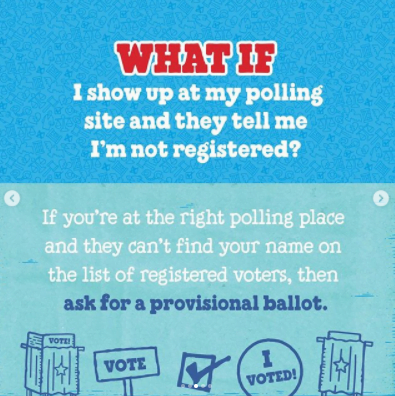
So… What does this all mean for marketers?
What this means is that there is a growing appetite on Instagram for educational and informative content. Audiences are looking for more than just filters and brunch spots, they are looking for substantive ideas. They are looking for inspiration and they are looking to act.
It’s also worth considering that a text-heavy images can communicate a message in a way that a stand-alone image cannot. Therefore, text-heavy content lends itself to being shared on Stories and via direct messages, which increases the likelihood of people seeing the content.
Text-heavy communication can also be persuasive, it allows direct communication with audiences through questions and communicates important messages in a short space of time. As marketers, we know social media users can be inherently lazy, so the quicker you can communicate a message, the better.
Can only activism accounts use text-heavy content?
Definitely Not. Text-heavy content is undeniably a fantastic way for activists to engage their audiences (for all the reasons outlined above.) However, as we become more familiar with this new visual style, we will expect to see more brands getting involved.
So to conclude, if your social and content team start suggesting PowerPoint-style presentations, they have not gone mad. Instead, they have identified the latest visual trend and are creating content in line with that trend.
There are usually a number of reasons as to why your content has not managed to succeed with outreach. It could be the timing, lack of a connection with the journalist, the manner in which it was sold in, a wrong choice of audience, a lack of wide appeal or even the way the content is branded.
Branded and unbranded content – what’s the difference?
Branded content is clearly about your company, and is usually promotional or advertorial. Unbranded content isn’t specifically about your company but is relevant to your industry or product in some way.
When it comes to branded and unbranded content in SEO outreach, branded outreach content could be a press release, while unbranded outreach content might be an infographic showing data relevant to your industry.
Blatant advertising
Branded content is often considered a pitfall when it comes to content marketing. Creating a piece that has been branded heavily can limit outreach potential. This is mainly down to the fact that most sites and publications view branded content as ‘advertorial’ or advertising, thus requiring, in their minds, payment for placement.
Most sites and blogs also have a very engaged audience and can monetize on this opportunity when working with other businesses. They are therefore more likely to request payment in order to feature branded content as they understand the value of the link that will direct traffic or brand awareness when being featured on their site.
Branded content can also be seen as product-driven, and is therefore less likely to be used by journalists or bloggers for referencing within their own content.
Successful unbranded content
So what does unbranded content look like? Minimal branded content that drives engagement (both organically and through proactive outreach) is usually expert-led, engaging, topical and most importantly, informative.
Good content will always strive to create a conversation, identify and solve problems and engage audiences.
Create a conversation
Online clothing start-up Wren tackled one of the most common marketing hurdles: creating a conversational piece on a low budget. However, they managed to pull it off (no pun intended).
They decided to create a short film called First Kiss, where 20 strangers got together to kiss one another for the first time. The film cost only $1,500 accumulating 110 million YouTube views, with over 1.1 million shares across Buzzfeed. The film saw a significant amount of media success too with coverage from The Guardian, the New York Times and CNN.
The reason the film worked so well was simply that the content you saw was what you got. It was all about the awkward first kiss, and less so about the actual clothing brand, even though the clothing featured in the film and a brief production title “Wren presents” at the beginning.
So did the film work in terms of a return on investment? Yes. And it worked very well.
- 1,400 percent increase in sales
- 15,000 percent increase in traffic
- 96 percent first-time visitors
Identify and discuss problems
Blinds specialist Hillarys set out to determine the effects of sleep loss and why many have issues with getting the recommended eight hours of sleep per night. Armed with research and data from the Sleep Foundation as well as unique research using survey data, it created the Lost Sleep Calculator where the user enters in their average hours of sleep per night and age to find out how much sleep they would lose on average every week, month year and lifetime.

The tool was a success, by identifying and highlighting the issues around sleep loss, the tool garnered over 40 links and 500 shares across Facebook, Twitter and LinkedIn and all with minimal branding.
Engage your audience
Great content doesn’t always have to be created online. Scandinavian voluntary missions board Frivillig created an emotional digital out of home campaign in Oslo.
The volunteer site designed the campaign to encourage people to spend time talking to lonely and isolated senior citizens through a webcam and screen set-up within a JC Decaux-managed transit shelter. It engaged commuters waiting at the bus shelter by striking up a conversation between them and the senior citizen live through the screen. While they talk and engage with the senior citizen, a coffee is poured, with the dispenser synced with the video-cam feed showing the man pouring. It truly is a unique and engaging campaign.
The campaign has accumulated over 5,000 views on YouTube receiving mentions from advertising press for its encouraging message and individuality.
Making unbranded content work
As more and more brands shift towards unbranded strategies we see a new and subtle take on creating brand awareness. This shift has allowed brands to connect with consumers on a new level, attempting to inform, speak to and engage with them.
When conceptualising a content campaign, take some time to consider the following:
- Does it focus on the product too much?
- How will the content create a conversation?
- Will it add value to the viewer’s life?
- Is it informative?
Unbranded content should always try to place an emphasis on the content itself, the message and the audience.
Whether you write weekly, monthly or quarterly blogs for your clients, coming up with fresh content ideas for blogs can get tougher as time passes. Finding new things to say on a specific niche topic or specialist subject doesn’t always come naturally to copywriters, who might not be experts in that particular field. If you’re struggling with blog ideas to flesh out your content calendar, these tactics should help.
Set up Google Alerts
Whatever industry your client is in, setting up Google alerts means you’ll always be one step ahead when it comes to breaking news stories. Google Alerts monitors the web for mentions of specific keywords you choose. While it makes sense to monitor specific brand terms, it can also be helpful to monitor generic industry-related terms too.
So, if your client was a travel company, setting up alerts for “holidays” “vacations” and “flights” will mean you have a fresh supply of news stories and updates delivered to your inbox as they happen. Go to google.com/alerts and enter a search term to track for blog inspiration.
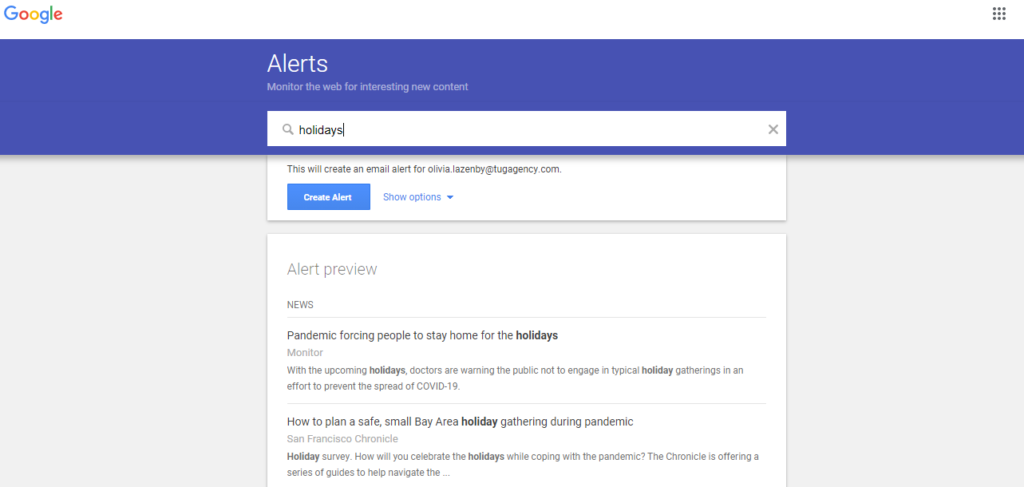
Update existing blogs
If your client’s blog has been active for several years, this can be a great source of inspiration. Older blogs might include outdated information, or could be written in a way that isn’t optimised for SEO to the standards you would recommend. Updating older blogs with new information or optimising them for keywords can produce great results with a minimum of effort. Creating follow-up blogs with more detailed information and linking to the older pieces is another option.
Feedly
Consuming content is just as important as creating it. Reading online articles and thought pieces, watching vlogs, looking at memes and laughing at the latest viral joke on social media isn’t just entertaining, it helps content creators understand what kinds of content work (and don’t work), and ensures that the content you create is fresh, fun and engaging.
Curate your own content library with Feedly. Organise your sources into Feeds by client or industry, save articles to read later, and skim-read the insights you need to keep ahead.
Answer the Public
One easy way to find blog topics is by answering questions people are searching for in your client’s field. How can you find out what questions they’re asking? With Answer the Public. Simply type in a word or phrase and the tool will return dozens of commonly asked questions in that area. So, let’s say I searched for “holidays” again, some of the questions returned are:
- Are holidays allowed?
- Are holidays to Spain cancelled?
- Why holidays are important for students
- Will holidays go ahead in October
- Holidays where you don’t need to quarantine
- What holidays can I go on?
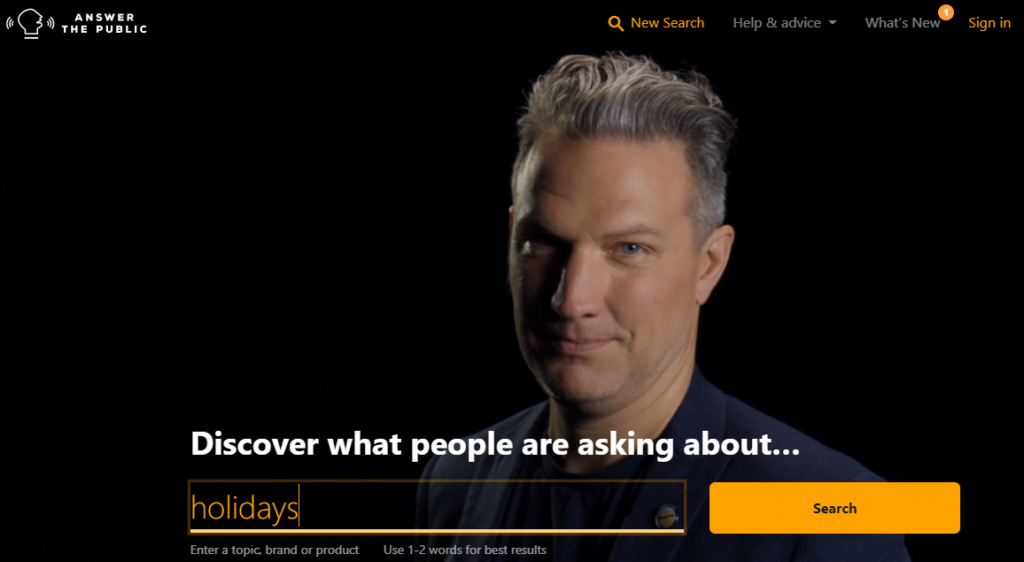
Repurpose existing content
From whitepapers and infographics to industry updates, press releases and social media posts, many content forms can be repurposed into blogs to work even harder. Ask the client to keep you in the loop from their end so that you are aligned with the content they’re sending out on their channels.
Online Forums
Websites like Reddit and Quora might be fun for light entertainment and falling down conspiracy theory rabbit holes, but for digital marketers, they can be a treasure trove of information. Subscribe to industry-specific threads to chat with other digital marketers, or simply lurk to learn about algorithm updates and new social media features before they make the headlines. These sorts of updates and insights can help you generate ideas for new types of content.
Could browsing Facebook and Instagram be a thing of the past for Europeans? That’s what appears to be on the cards after a recent court filing.
Facebook is currently in a legal battle with the Data Protection Commission over a recent order which called into question the way Facebook sends data back to the USA.
Facebook has threatened to stop operating its Facebook and Instagram apps in the EU region – removing the service from the 410 million active European users.
Facebook has also challenged the order, saying that it and many other businesses rely on data transfers between the EU and the USA in order to operate. It also complained that it was being unfairly targeted by the Data Protection Commission, as the only US-based tech company which was subject to this order.
The core of the issue is the manner in which Facebook transfers data between continents – called standard contractual clauses (SCCs). To quality to use these transfer systems, companies must demonstrate a high level of data privacy; the concern being that US data surveillance is too invasive for EU standards.
The thought of Facebook and Instagram disappearing from European mobile screens seems too unlikely to be entertained (according to Statista they earned US$4.2 billion in Europe in Q1 of this year) – but how likely is it? Asher Gordon, Head of Biddable at Tug London said: Never say never, but it is extremely unlikely that Facebook will pull out of Europe, and this situation is probably a bit of posturing from them. This will lead to some additional talks with Europe and likely some concessions from Facebook. One thing we know for sure is that there is more to come from this story. Big tech companies are no stranger to pressure from international government and do sometimes concede to pressure, most recently in February when Facebook founder Mark Zuckerberg ‘agreed’ that the company may have to pay more tax in Europe.
